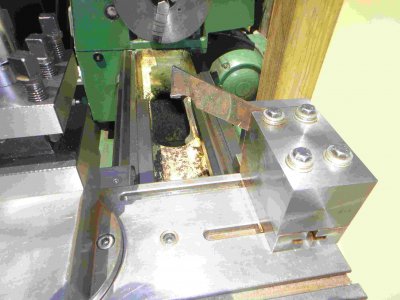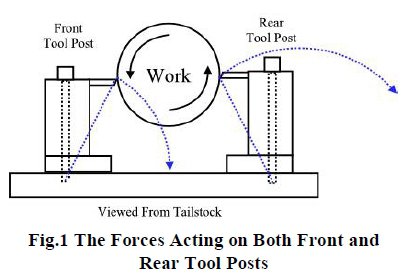i have two commercial cutoff tools for my bxa tool post. they both have back rake built into them. your holder dose not appear to have any rake, that may contribute to the problem. the tool must be on center to cut properly. on small lathes lock everything down. i would try high speed steel cutoff blades ,they require less pressure to cut and you can sharpen them yourself.. sometimes i find it necessary to use the tailstock for additional support. just back off prior to cutting through. this is a good way to test for loose spindle bearings. keep your tool stickout to the minimum amount needed to cutoff. when dealing with small lathes you kind of have to experiment with tooling and set ups to find a combination that works with your lathe.Here's a tool post I made for my Logan 200 lathe. The AXA post I have has the capacity for a 1/2" cutoff blade and I was hoping a 3/4" blade would be more rigid. The post works but really no better than the 1/2 blade on the AXA post. Does anyone have any suggestions for as to how to stop a tremendous amount of chatter? I've tried high speed and the slowest speeds. The slowest is by far the best but still not great. I also checked the bearing in my head stock... as near as I can tell I have about .001 slop in the bearing which doesn't seem excessive to me.
I suspect I'm expecting a bit to much from a small lathe. The compound is nowhere near as solid and other lathes and the 1.5" head stock probably flexes under load. Still I'm hoping somebody has a good suggestion as to how to improve the chatter I'm getting. Thanks.
View attachment 122765
-
Welcome back Guest! Did you know you can mentor other members here at H-M? If not, please check out our Relaunch of Hobby Machinist Mentoring Program!
You are using an out of date browser. It may not display this or other websites correctly.
You should upgrade or use an alternative browser.
You should upgrade or use an alternative browser.
Cutoff Tool
- Thread starter Mork
- Start date
Hi all. This is my first time here so please be gentle with me! I thought these few notes might turn out to be useful to someone. I am just a self taught beginner at machining since 1984. As with all of us I went through the mill (Ha ha pun intended) learning to part off confidently. With very small jobs I still use HSS in the tool post as its easy to grind to whatever shape/diameter is needed at the time. I also built a back parting off tool with a carbide tip for big jobs and it will do the most amazing things. (See pic) I just can't make it fail. It will turn off 2 1/2" mild steel at top speed (1500 rpm). I can force the tool in to the work so hard the swarf comes off glowing red hot. Mind you I only did that once to see if I could. Mostly I keep it to no colour or light blue. I never have any chatter and of course with carbide I don't use lubricant. (Sharp eyed observers will note that its time I had my tip sharpened.)
I thought these few notes might turn out to be useful to someone. I am just a self taught beginner at machining since 1984. As with all of us I went through the mill (Ha ha pun intended) learning to part off confidently. With very small jobs I still use HSS in the tool post as its easy to grind to whatever shape/diameter is needed at the time. I also built a back parting off tool with a carbide tip for big jobs and it will do the most amazing things. (See pic) I just can't make it fail. It will turn off 2 1/2" mild steel at top speed (1500 rpm). I can force the tool in to the work so hard the swarf comes off glowing red hot. Mind you I only did that once to see if I could. Mostly I keep it to no colour or light blue. I never have any chatter and of course with carbide I don't use lubricant. (Sharp eyed observers will note that its time I had my tip sharpened.)
As we all know parting from the tool post is much more fraught so if I am using that method for small parts I use plenty of lubricant and slow speed, frequently withdraw the tool and brush out the slot with a old tooth brush using a separate brush to dribble oil on the cut. One has to use ones brain, ears and fingertips to be sensitive to how the cut is going and how much feed is required. As someone else mentioned too light a cut and slow feed can cause chatter, too heavy cut and too fast feed can jam the tool and you need to be able to "feel" each time it needs cleaning out. These days I usually get away with it.
Not sure about all the theory of the back parting off tool but I have always suspected that because the tool is upside down the chips/swarf clear the cut by gravity and that helps everything along.
Hope this helpful to someone, I will get off the soapbox now! Cheers all Joe

As we all know parting from the tool post is much more fraught so if I am using that method for small parts I use plenty of lubricant and slow speed, frequently withdraw the tool and brush out the slot with a old tooth brush using a separate brush to dribble oil on the cut. One has to use ones brain, ears and fingertips to be sensitive to how the cut is going and how much feed is required. As someone else mentioned too light a cut and slow feed can cause chatter, too heavy cut and too fast feed can jam the tool and you need to be able to "feel" each time it needs cleaning out. These days I usually get away with it.
Not sure about all the theory of the back parting off tool but I have always suspected that because the tool is upside down the chips/swarf clear the cut by gravity and that helps everything along.
Hope this helpful to someone, I will get off the soapbox now! Cheers all Joe

- Joined
- Dec 20, 2012
- Messages
- 9,422
Guys, at the end of the day, it doesn't really matter why a parting tool works from the rear or not. There are all kinds of theories and opinions and to my knowledge not a single one has been proven, including my own. In the past, the Brits have been the most vocal about the benefits of rear mounted tools, most notably GH Thomas, but as far as I know he never did any vector analyses. Even Myford, who sold a rear mounted tool post, did not prove anything. All they did was publish a picture of how they thought the forces went and commented that perhaps parting from the rear prevented dig ins as the cutting forces were encountered:

I do know that a rear mounted parting tool works rather well. Why it works is not as important as the fact that it works well. I do not mean to imply that it is the only way or that it is better than parting from the front - it clearly is not for many of us - but it is a viable option and it beats the heck out of using a hacksaw.

I do know that a rear mounted parting tool works rather well. Why it works is not as important as the fact that it works well. I do not mean to imply that it is the only way or that it is better than parting from the front - it clearly is not for many of us - but it is a viable option and it beats the heck out of using a hacksaw.
Count me in with the folks who want to know why a certain method or tool works better or worse than another. Before I make a special rear parting holder and blade it would be important to understand the critical design features that will make it better than what I already have.
The 'whys' that I have learned so far about using a lathe properly have been fascinating and satisfying.
The 'whys' that I have learned so far about using a lathe properly have been fascinating and satisfying.
Joe, welcome aboard and thanks for the picture. That is an interesting design. If it puts the cutting blade in tension instead of the usual bending mode I am sold. However I am not able to visualize how it cuts and how to feed it. Any details that you could provide would be appreciated.
- Joined
- Nov 21, 2010
- Messages
- 1,602
food for thought cause I didn't see this mentioned. Front or back I don't think it matters but
most parting is done from front for a tool change. For the most part most buy HF or China
blades (me too) because we do a lot of brass parts and they work fine, but have you looked
at the end of the blade while holding the tool holder in your hand.? You will find the blade
is crooked. Therefore I use two blades, one upside down, now the cutting edge is vertical.
Get the picture. End view thick at the top narrow at the bottom equals a cocked blade........
most parting is done from front for a tool change. For the most part most buy HF or China
blades (me too) because we do a lot of brass parts and they work fine, but have you looked
at the end of the blade while holding the tool holder in your hand.? You will find the blade
is crooked. Therefore I use two blades, one upside down, now the cutting edge is vertical.
Get the picture. End view thick at the top narrow at the bottom equals a cocked blade........
- Joined
- Sep 29, 2014
- Messages
- 2,102
Having never used a hobbyist type lathe I have no experience here.
That being said, I can not see any advantage to parting from the back unless one has run out of room for another tool on the cross slide or cycle time is a priority.
I suppose that lifting the cross slide off of the ways may impart a bit of chatter relief, this again I do not know, interesting concept however.
That being said, I can not see any advantage to parting from the back unless one has run out of room for another tool on the cross slide or cycle time is a priority.
I suppose that lifting the cross slide off of the ways may impart a bit of chatter relief, this again I do not know, interesting concept however.

